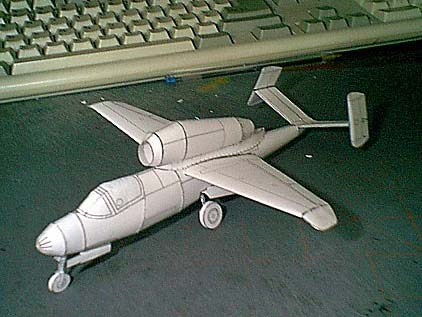



Heinkel He-162 Salamander Volksjager Nazi Jet Fighter
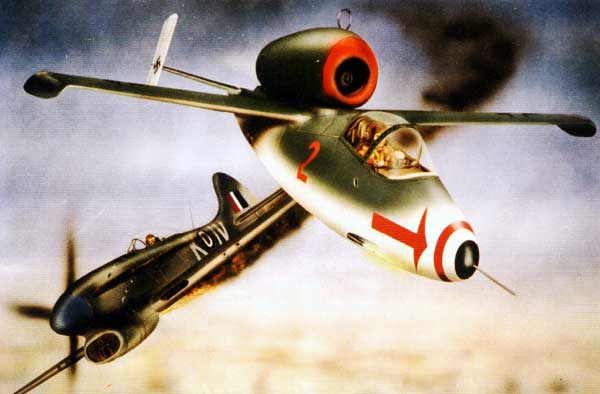
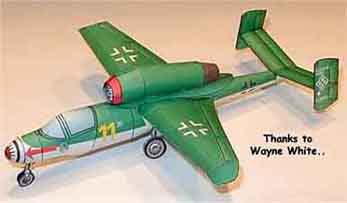
The prototype of the Heinkel He 162 turbojet-engine interceptor was flown for the first time on 6 December 1944, only 38 days after detail drawings had been issued to the factory. This prototype was lost in a fatal flying accident on 10 December, but the program was continued and revealed some aerodynamic problems, these being remedied in the third and fourth prototypes, both flown on 16 January 1945; first deliveries of aircraft for operational evaluation and service trials were also made during January 1945.
On 4 May 1945 one Gruppe of three squadrons, with a total of 50 aircraft was formed at Leck in Schleswig-Holstein, but British forces occupied the air field on 8 May and accepted the unit's surrender. A total of 116 He 162s was built, and more than 800 were in various stages of assembly when the underground production centers were captured.
JET FIGHTERS IN WORLD WAR II?
Yes, the Germans flew them, but fortunately for the Allies, they arrived too late to affect the outcome of the war. Heinkel's He 162 made conventional fighters look like lumbering bombers as it skipped along at over 500 mph. Surprisingly, much of its structure was wood, a "non-strategic" material. The He 162 was rushed to production in late 1944 and first flew on December 6. More than 100 of the graceful Volksjager (people's fighter) were completed, with another 800 nearly finished at war's end. However, only a handful of the planes proved to be airworthy.
Heinkel He-162 Salamander Volksjager German Jet Fighter

The Volksjager (people's fighter), otherwise known as the Salamander
or Spatz (sparrow) was planned, designed and flown in just 10
weeks during 1944 as a high-performance defensive fighter making
minimal demands on strategic materials and skilled man power.
The first of many prototypes flew in December 1944 as a shoulder-wing
monoplane of largely wooden construction but fitted with tricycle
landing gear and a tailplane with endplate vertical surfaces so
that the single turbojet could be mounted in an easy maintenance
position above the fuselage. A number of handling deficiencies
were countered by the enlargement of the vertical tail surfaces,
anhedralling the wingtips and moving forward the centre of gravity
in the He 162A production model. About 250 were completed but
a bit late to see combat.
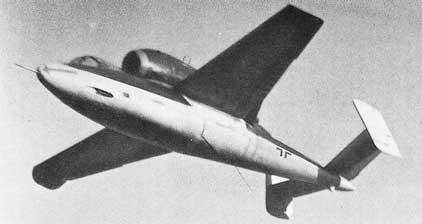 The overwhelming Allied air power and devastating air raids
carried out over Germany after 1943 had made it clear to the Luftwaffe
leadership that large numbers of advanced piston-engine fighters,
such as the Fw 190D, Ta 152H or Bf 109K, in conjunction with the
new jet fighters, must be manufactured.
The overwhelming Allied air power and devastating air raids
carried out over Germany after 1943 had made it clear to the Luftwaffe
leadership that large numbers of advanced piston-engine fighters,
such as the Fw 190D, Ta 152H or Bf 109K, in conjunction with the
new jet fighters, must be manufactured.
Since the development of the Me 262 jet fighter was more time-consuming than originally anticipated, there was a pressing need for a light, fast, single-jet fighter capable of being built in large numbers, using non-strategic materials. One of the first proposals to meet this requirement was the Heinkel He-P 1073, which was a turbojet fighter project to be powered by an HeS 011. It was similar to, but not identical with, that which later became the He 162 W (People's fighter).
Several of its features were adopted however, for a low-cost simple fighter aircraft. When on September 8, 1944, the Technische Amt announced a competition for a so-called Volksjager. Since Heinkel was already evolved a similar project some months earlier, a design proposal was quickly drafted and submitted to the Technical Office within a matter of days. After a short assessment, the Heinkel design was accepted and a contract awarded on September 29, 1944, without any prototype having been completed or tested.
Concurrently, several other aircraft manufacturers also engaged in the design of a Volksjager. One of the design studies proposed was the Arado E 580 TL Jager... a single-seat fighter powered by one BMW 003 turbojet which was remarkably similar to the Heinkel project. The airframe was to be made from steel, combined wooden wings and tail assembly.
A tricycle undercarriage. with wide-track main wheels, was incorporated. Curiously, the turbojet engine was mounted snugly on top of the fuselage with the rear portion of the cockpit canopy protruding into the air-intake. It had a length of 25.25 ft and a wingspan of 25.5 ft. Armament was to consist of one or two MK 108s with 60 rpg. A top speed at ground level of 429 mph , and 466 mph at 32,800 ft, had been calculated.
Because neither the air-intake arrangement nor the estimated performance were acceptable, Technisches Amt and OKL rejected further development of the Ar E 580 design, an updated description of which was finalized on September 12, 1944.
Variants
He 162A: the 10 prototypes were also designated He 162A-O as pre production aircraft; initial production He 162A-1 fighters were followed by the more extensively-built He 162A-2 which introduced further aerodynamic changes to enhance stability.
 One of the most rapidly
conceived warplanes ever produced, the He 162 home defense fighter
existed as a wooden mockup within IS days of the issue, on 8 September
1944, of the RLM requirement. Seven days later a huge production
contract was placed; detail design drawings were completed by
the end of October; and on 6 December 1944 - less than 13 weeks
from initiation of the program - the He 162 Vl (or A-0 1) made
its first flight.
One of the most rapidly
conceived warplanes ever produced, the He 162 home defense fighter
existed as a wooden mockup within IS days of the issue, on 8 September
1944, of the RLM requirement. Seven days later a huge production
contract was placed; detail design drawings were completed by
the end of October; and on 6 December 1944 - less than 13 weeks
from initiation of the program - the He 162 Vl (or A-0 1) made
its first flight.
Dubbed, for propaganda purposes, the Volksjager or People's Fighter, the He 162 was of attractive if unorthodox appearance and was built largely of wood and other non-strategic materials. Its looks, however, belied a dangerous instability and some vicious handling characteristics, and troubles were also encountered (as in the Focke Wulf Ta 154) with the wood-bonding adhesive used. Under the high priority given to fighter programs in 1944-45, manufacture of the He 162, under the code name Salamander, was assigned to numerous factories. It was planned to produce produce 2,000 a month by May 1945 and 4,000 a month ultimately, and about 800 were in various stages of assembly when the war in Europe ended. A further 280 or so 162A-Os, A-ls and A-2s had actually been completed.
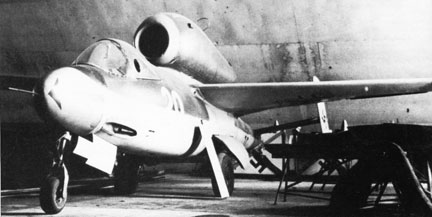 One of the many He 162 A-2s captured by
British troops at Leck airfield is this example, white 20. The
distinctive camouflage pattern identifies this example as having
been built at Heinkel's Marienehe facility on the Baltic. One of the many He 162 A-2s captured by
British troops at Leck airfield is this example, white 20. The
distinctive camouflage pattern identifies this example as having
been built at Heinkel's Marienehe facility on the Baltic. |
A close-up
view of He 162 fuselages being constructed on their jigs within
Heinkel's southern underground facility at Hinterbrohl near Molding,
in the spring of 1945. This view shows the lower part of the
forward fuselage.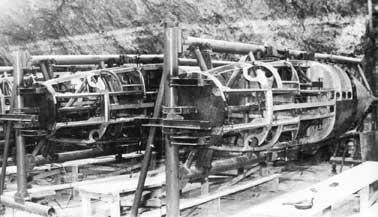 |
The first Luftwaffe unit to fly the He 162A was Erprobungskommando 162, which began to receive these aircraft in January 1945; but the first operational units, I. and II. / JG I, were still working up at the beginning of May.
Consequently, very few He 162s were actually encountered in combat. Proposed later versions included He-162A sub-types up to A-14, the He 162B (one or two pulse jet engines), the He 162C (swept-forward wings), the He-162D(swept-back wings), and models with combined jet and rocket propulsion.
The ''Volksjager'' (People's Fighter), was an incredible aircraft and left behind so many conflicting impressions it is hard to believe the whole program was started and finished in little more than six months.
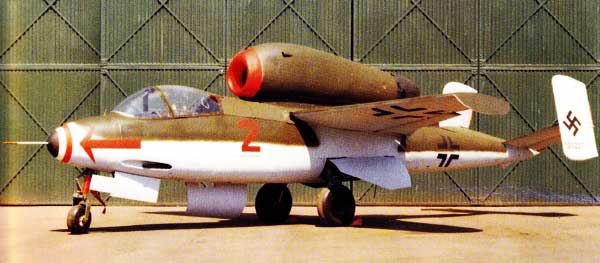
To appreciate the almost impossible nature of the program, Germany was being pounded to rubble by fleets of Allied bombers that darkened the sky, and the aircraft industry and the Lultwaffe's fuel supplies were inexorably running down Experienced aircrew had nearly all been killed. materials were in critically short supply and time had to be measured not in months but in days.
So on 8 September 1944 the RLM issued a specification calling for a 750 km/h jet fighter to be regarded as a piece of consumer goods and to be ready by 1 January 1945. Huge numbers of workers were organized to build it even before it was designed and Hitler Youth were hastily trained in primary gliders before being strapped into the new jet Heinkel, which had built the world's first turbojet aircraft (He 178. flown 27 August 1939) and the first jet fighter (He 280 twin-jet flown on its jet engines 2 April 1941) won a hasty competition with a tiny wooden machine with its engine perched on top and blasting between twin fins.
Drawings were ready on 30 October 1944 .The prototype flew in 37 days and plans were made for production to rise rapidly to 4.000 per month Despite extreme difficulties. 300 of various sub-types had been completed by VE day with 800 more on the assembly lines.
A view of one of
the many tunnels at Hinterbrohl as they appear today. Some of
these are still bricked off from 1945, leading to speculation
of what might be found on the other side. 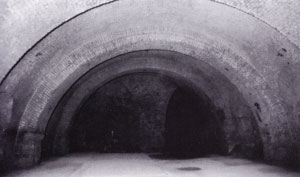 |
I/JG1 was operational at Leck... though without fuel. Despite many bad characteristics the 162 was a fighter of a futuristic kind, created in quantity far quicker than modern aircraft are even drawn on paper.One of the last aircraft to bear the insignia of the Luftwaffe before the final defeat was the Heinkel He.162 Salamander, once again a jet combat plane, it was built in the record breaking time of only three months. The program was launched officially on September 8, 1944, and the first prototype took to the air on December 6.
All this haste was caused by the simple need to send into combat an interceptor which had a performance equal to that of the Messerschmitt Me.262, but which cost less, and which could be constructed using the same engine and non-strategic materials. Moreover, its construction needed to be simple enough overall to mean that it could be entrusted to a not particularly skilled workforce. The difficult terms of this complex equation were entirely solved by Heinkel, although the disastrous conditions that existed in Germany during the final months of the war actually prevented the ambitious production program from being carried out.
The intended program foresaw the construction of no fewer than 4,000 aircraft per month, involving three different manufacturers. In the end, only 116 Salamanders came off the assembly lines (after the war, another 800 were found at various stages of construction in German factories below ground), and very few of them went into service.
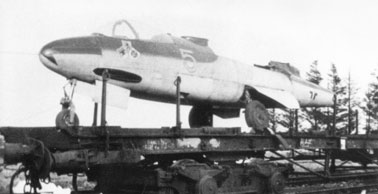 This disassembled He 162 A-1, yellow
5, of 3./JG 1, was built by Mittelwerk at Nordhausen. Note the
unit emblems for all three Squadrons within JG 1 painted on the
forward fuselage. This disassembled He 162 A-1, yellow
5, of 3./JG 1, was built by Mittelwerk at Nordhausen. Note the
unit emblems for all three Squadrons within JG 1 painted on the
forward fuselage. |
Almost all of the major German aeronautical manufacturers participated in the specifications for the construction of the Volksjager (people's fighter, as the project was christened officially): Arado, Blohm und Voss, Fieseler, Focke Wulf, Junkers, Messerschmitt and Heinkel. In the end, on September 30, 1944, the project submitted by Heinkel was chosen. The company's technicians had not been especially daunted by the particularly severe requests as far as development time was concerned (the prototype was to have been ready for December 1 and production was to begin exactly a month later) and they prepared the first experimental aircraft in great haste.
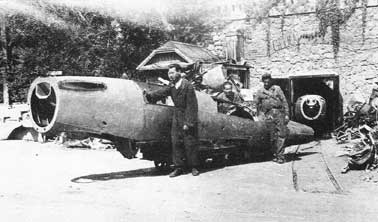
|
Objectively, the aircraft was an unusual one. It was a high wing monoplane with inclined twin tail planes. It had a small metal and wood fuselage in which the retractable forward tricycle landing gear, and the pilot's position (provided with ejectable seat and canopy) were installed, as well as the armament consisting of two 30 mm caliber cannons (later replaced by two 20 mm weapons for structural reasons) and the engine, the latter being housed in fairing on the aircraft's back. As for the wings, their frame and covering were entirely made of wood.
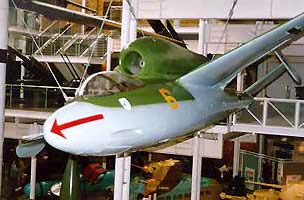 However, the initial series of tests was not successful. When
the first prototype took to the air from Heinkel's field at ViennaSchwechat,
a structural failure was revealed (due to the breakage of one
of the covers of the landing gear housing) probably caused by
a welding error. On December 10 during a demonstration before
the military authorities, a wing gave away and the aircraft fell
while flying at high speed at low altitude, crashing to the ground.
Once again, the cause of the failure was attributed to a welding
error, and the program went ahead all the same, encouraged by
the excellent overall performance demonstrated prior to the accident:
good overall flying characteristics and high speed, in the region
of 521 mph at 19,736 ft.
However, the initial series of tests was not successful. When
the first prototype took to the air from Heinkel's field at ViennaSchwechat,
a structural failure was revealed (due to the breakage of one
of the covers of the landing gear housing) probably caused by
a welding error. On December 10 during a demonstration before
the military authorities, a wing gave away and the aircraft fell
while flying at high speed at low altitude, crashing to the ground.
Once again, the cause of the failure was attributed to a welding
error, and the program went ahead all the same, encouraged by
the excellent overall performance demonstrated prior to the accident:
good overall flying characteristics and high speed, in the region
of 521 mph at 19,736 ft.
The series of tests was completed by another two prototypes and 31 pre-series aircraft, which were evaluated between January and February, 1945. These were followed by the first production series aircraft, designated He.162 A-2, which were fitted with a more powerful engine and standardized armament consisting of two 20 mm cannons. The Salamander's combat career was virtually non-existent.
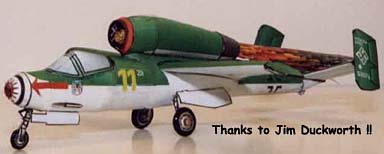 |
This is the close to the final mock up the Chauncy did to 'proof' his design... The model looks great in white doesn't it?? Notice also that 'his' desk is so clean.. This leads us to suspect that this photo was taken at a friend's house..
|
|
A neat plastic model of the Salamander:
Bob flies medical evacuation helicopters from the Twin Cities in Minnesota. For relaxation he builds World War II aircraft models in 1/48 scale. |
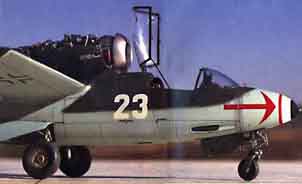 |
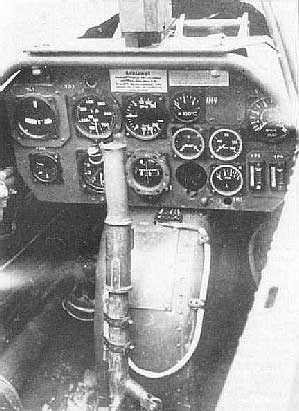 |
Heinkel He162 Salamander Cockpit. |
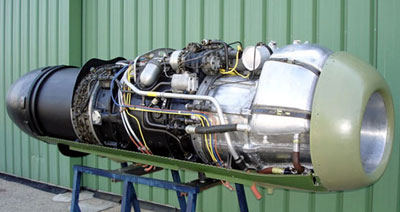 |
Engine of the Heinkel He162 Salamander. |
Specifications for the Heinkel He-162 Salamander
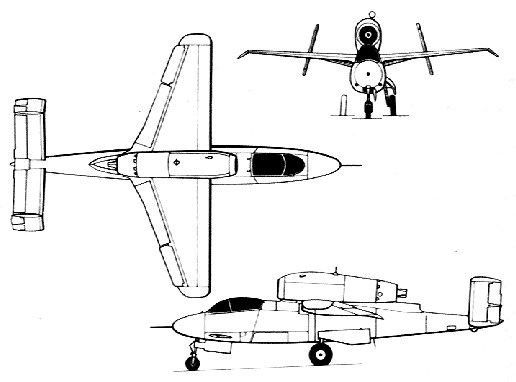 |
Length: 29 ft 8 in |
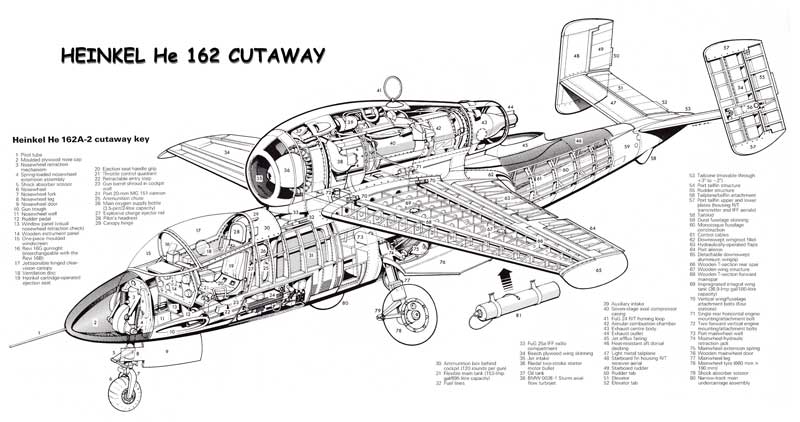 |
This wonderful He 162 Salamander Cutaway comes in full size 8.5x11 PDF for FREE in your MyModels folder. |



